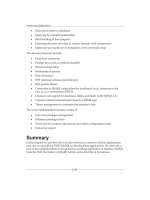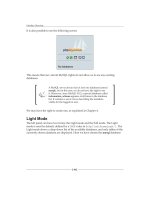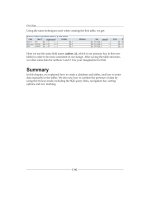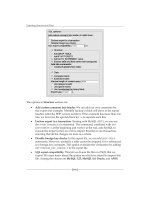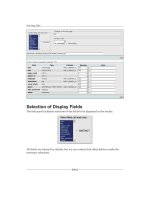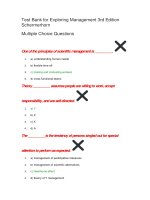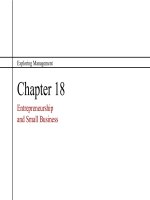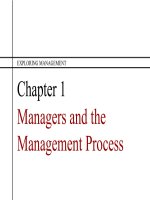Exploring management 3rd ch15
Bạn đang xem bản rút gọn của tài liệu. Xem và tải ngay bản đầy đủ của tài liệu tại đây (695.53 KB, 25 trang )
Exploring Management
Chapter 15
Communication
Chapter 15
•
•
•
What is communication and when is it effective?
What are the major barriers to effective communication?
How can we improve communication with people at work?
15.1
Effective Communication
•
•
•
•
Communication is a process of sending and receiving messages with
meanings attached
Communication is effective when the receiver understands the sender’s
messages
Communication is efficient when it is delivered at a low cost to the sender
Communication is persuasive when the receiver acts as the sender
intends.
EFFECTIVE COMMUNICATION
Communication Process
Communication
Use
Use e-mail,
e-mail, voicemail,
voicemail,
– Process of sending and
text
text messaging
messaging
receiving messages
Give
Give and
and receive
receive
Write
Write memos,
memos, letters,
letters,
feedback
feedback
reports
reports
with meanings attached
Check Your Communication
Work
Work well
well in
in teams
teams
Network
Network with
with peers
peers and
and
mentors
mentors
Skills
Give
Give persuasive
persuasive
Conduct
Conduct job
job interviews
interviews
presentations
presentations
Run
Run meetings,
meetings, contribute
contribute
to
to meetings
meetings
EFFECTIVE COMMUNICATION
Communication Process
EFFECTIVE COMMUNICATION
Communication Process
•
Effective Communication
– Receiver must understand the sender’s message
•
Efficient Communication
– Communication occurs at minimum cost
EFFECTIVE COMMUNICATION
Communication Process
•
Persuasive communication
– Convincing others to accept, support and act on the message
•
Credible communication
– Earns trust, respect and integrity
15.2
Communication Barriers
•
•
•
•
•
Poor use of communication channels makes it hard to communicate
effectively
Poor written or oral expression makes it hard to communicate effectively
Failure to spot nonverbal signals makes it hard to communicate effectively
Status differences make it hard to communicate effectively.
Physical distractions make it hard to communicate effectively
COMMUNICATION BARRIERS
Communication Channels
•
•
Poor use makes effective communication difficult
Noise interferes with the communication process
COMMUNICATION BARRIERS
Communication Channels
•
Communication channels
– Medium used to carry message
•
Channel richness
– Ability of the channel to convey meaning
COMMUNICATION BARRIERS
Communication Channels
•
Poor written or oral expression makes it hard to communicate effectively
COMMUNICATION BARRIERS
Communication Channels
•
Nonverbal communication
– Gestures, expressions, posture and interpersonal space
– Mixed messages
•
Words and
nonverbal signals
don’t match
COMMUNICATION BARRIERS
Communication Channels
•
Status differences
– Filtering distorts information to make it more favorable to recipient
COMMUNICATION BARRIERS
Communication Channels
•
Physical distractions
– Plan message to minimize distractions and interruptions
15.3
Improving Communication
•
•
•
Active listening helps people say what they really mean
•
Transparency and openness ensure that accurate and timely information
is shared
Constructive feedback is specific, timely and relevant
Office spaces can be designed to encourage interaction and
communication
15.3 Continued
Improving Communication
•
•
Appropriate use of technology can facilitate more and better
communication
Sensitivity and etiquette can improve cross-cultural communication
IMPROVING COMMUNICATION
Listening
•
Active listening
– Helps the source of a message say what he or she really means
IMPROVING COMMUNICATION
Listening
Listen for message content
Listen for feelings
Rules for better listening
Respond to feelings
Note all cues
Paraphrase and restate
IMPROVING COMMUNICATION
Feedback
•
Feedback
– Process of telling someone else how you feel about something that person did
or said
– Should be
•
•
•
•
•
At the right time
Genuine
Specific
Stick to the essentials
Given in small doses
Proxemics
•
Proxemics
– The study of the way we use space
– Physical distance between people conveys varying intentions in terms of
intimacy, openness, and status.
IMPROVING COMMUNICATION
Openness
•
Communication transparency
– Honest, open, accurate and complete information
•
Open-book management
– Employees are given essential financial information about their employers
IMPROVING COMMUNICATION
Physical Setting
•
Work spaces designed to encourage interaction and communication
– Proxemics
IMPROVING COMMUNICATION
Technology
•
Appropriate use of technology can facilitate more and better
communication
– Text
– Social networking
IMPROVING COMMUNICATION
Technology
•
Electronic grapevine
– Transmit information around informal networks inside and outside the
organization
IMPROVING COMMUNICATION
Cross-Cultural Communication
•
Ethnocentrism
– Consider one’s own culture to be superior
•
Cultural etiquette
– Appropriate manners and behavior when communicating with people from other
cultures


